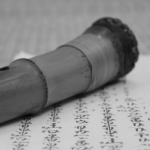Shakuhachi musical instrument
2019/9/26
 Many Japanese musical instruments are not functional in the same way as Western musical instruments, that is, playing fast, constantly producing large and stable sounds, or composing chords by simultaneously producing multiple sounds. I'm always betting on this one point, the tone. The shamisen sawari (although there is a similar concept to Indian stringed instruments), and the fact that the musicians of folk songs have been particular about playing with silk thread are examples of this tone-oriented appearance.
Many Japanese musical instruments are not functional in the same way as Western musical instruments, that is, playing fast, constantly producing large and stable sounds, or composing chords by simultaneously producing multiple sounds. I'm always betting on this one point, the tone. The shamisen sawari (although there is a similar concept to Indian stringed instruments), and the fact that the musicians of folk songs have been particular about playing with silk thread are examples of this tone-oriented appearance.
再 び Go back to the theme of Japanese musical instruments “tone lovers”. The shamisen “sawari” and the folding musician's commitment to silk are given as examples. The story of Nohkan along with derailment. Speaking of “obtaining a certain pitch with a certain fingering,” Noh tube is no longer an instrument. It is impossible to play a so-called melody in Noh. It is this Noh that is used only to create an atmosphere for describing a scene, beyond the standard of musical instruments. Mr. C. Evert is a teacher at Musashino University because he loves Noh and likes to be a Noh performer, but he cannot fulfill his nationality barrier (they are American men). He often came to listen to concerts in Japanese genres and other genres, and became very close (although I had forgotten all that happened so far). I have been tempted to give him a persistent nobility. At the end, I finally got it out and used it sometimes in studio recordings such as play accompaniment. The super high tone called “Hishigi”, which was peculiar to Noh, did not come out at last. Evert, who is also a master of shakuhachi himself, well understood my interest in the unique existence of Fukizen shakuhachi (classical song) and recommended it to a lecturer at the International Department of Waseda University. Wasn't he the English version of the song “Sumidagawa”?